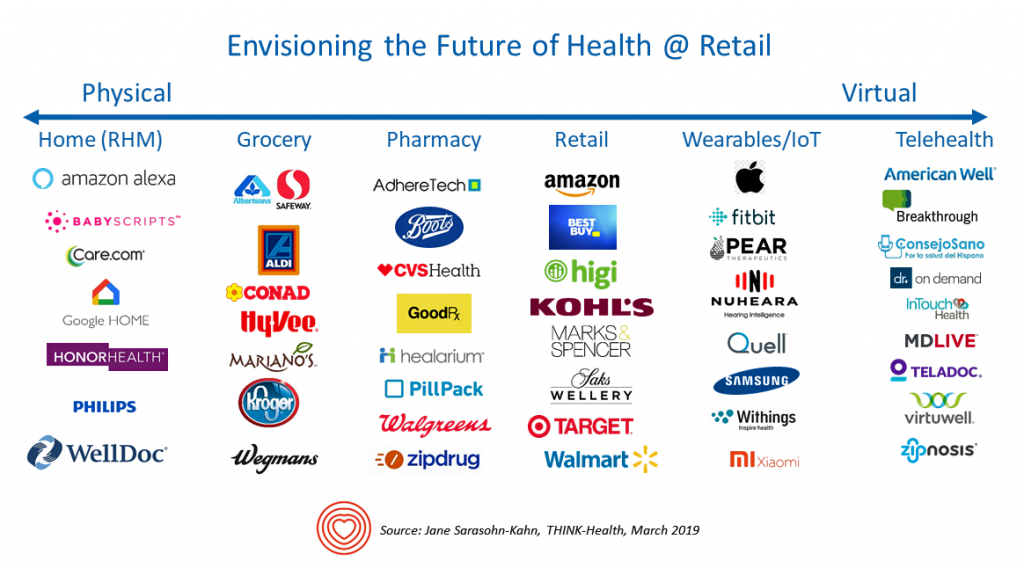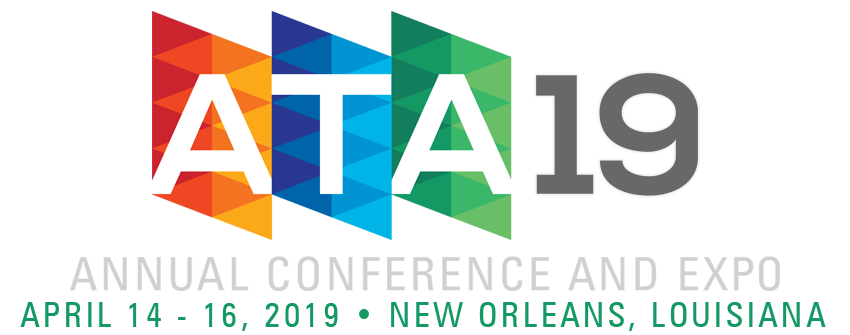“ATA” is the new three-letter acronym for the American Telemedicine Association, meeting today through Tuesday at the Convention Center in New Orleans. Ann Mond Johnson assumed the helm of CEO of ATA in 2018, and she’s issued a call-to-action across the health/care ecosystem for a delivery system upgrade.
Her interview here in HealthLeaders speaks to her vision, recognizing, “It’s just stunning that there’s such a lag between what is possible in telehealth and what is actually happening.”
I’m so keen on telehealth, I’m personally participating in three sessions at #ATA19. On Monday 15th April (US Tax Day, which is relevant to my talk), I’ll speak about re-imagining how telehealth cold re-shape the future of healthcare at a session curated by Dr. Joseph Kvedar of Partners Healthcare. This graphic is one image from my deck, which organizes a continuum of physical to virtual care platforms, and vertical applications from home care to food and grocery, pharmacy, retail, wearables and Internet of Things devices, and telemedicine channels.
 Lucky me, I get to dive deeper on Tuesday morning with one of the retailers on this chart, Best Buy, which acquired GreatCall last year. Best Buy Health has been developing partnerships in healthcare, in B2B2C mode, channeling into peoples’ homes for healthy living and aging well “in place.” Joining us on the panel will be Kaiser-Permanente as a prospective partner in such a retail health-to-services-to-home vision, underpinned by data and predictive analytics.
Lucky me, I get to dive deeper on Tuesday morning with one of the retailers on this chart, Best Buy, which acquired GreatCall last year. Best Buy Health has been developing partnerships in healthcare, in B2B2C mode, channeling into peoples’ homes for healthy living and aging well “in place.” Joining us on the panel will be Kaiser-Permanente as a prospective partner in such a retail health-to-services-to-home vision, underpinned by data and predictive analytics.
Closing out Tuesday, I’m the fortunate person who gets to interview Dr. Toby Cosgrove on the main stage. Dr. Cosgrove recently left his CEO post at Cleveland Clinic, where he pioneered telemedicine and virtual health in and beyond the Cleveland target market to the larger healthcare ecosystem. Cleveland Clinic is a prime example of a hospital system imagining and re-shaping what a hospital will be in the future. Hint: it will have a lot to do with data and analytics, and Dr. Cosgrove can speak to that as he’s joined Google Health as an advisor.
That “future” as Ann Mond Johnson notes is do-able “now.” The barriers to adopting virtual, digital, telehealth modes have been regulatory, financial, and cultural — not so much technical.
Those obstacles have begun to fall: FHIR standards, enabling the more liquid movement of data out of silos; payment re-aligning toward value and outcomes; Medicare Advantage plans bundling long-term supports to keep people well and out of expensive care settings (namely ERs and hospital beds); telehealth coverage expanding in employer-based health plans; and, evolving codes enabling providers to be paid for remote health monitoring encounters.
Finally, consumer-patient pressures are playing a positive role in telehealth adoption. As patients have morphed into consumers, now major payors of healthcare, people seek more enchanting, accessible, design-ful experiences as they do in retail.
Health Populi’s Hot Points: My graphic illustrates only some of the growing number of community-based touch-points for health and wellness services, from our local grocers and banks to faith-based institutions and barbershops.
Today, I announce my new book, HealthConsuming: From Health Consumer to Health Citizen, long-evolved over the past several years. It is time for me to share this message, which plots the patient-as-payor and health consumer. Whether we like the mantle of “consumer” in healthcare or not, it is what it is: the patient is the payor.
I’ll share more with you about the book throughout this week and ongoing as the book makes its way to Amazon in print and Kindle formats.
As a concluding point, in full transparency, I must note that Ann Mond Johnson and I go way, way back to the late 1980s into the early 1990s when we both worked in health care in Europe. Ann worked with Accor, the hotel chain, on health care projects, based in Paris; I lived in London, a consultant with the Touche Ross (now Deloitte) health care team, working with the NHS, the private health sector, and on the Continent.
Ann and I encountered each other at European health conferences, “the two American healthcare girls” in the European space. We’ve stayed close through the years, and so collaborating with #ATA19 is an especially sweet moment for me both personally and professionally.
Ann’s health-tech entrepreneurship through the years demonstrates her ability to envision new-new things that enable healthcare transparency, empower patient engagement and activation, and drive administrative efficiencies. If anyone can help us close the gap between what’s possible for telehealth versus where we are “now,” it’s this CEO of ATA.





 I love sharing perspectives on what's shaping the future of health care, and appreciate the opportunity to be collaborating once again with Duke Corporate Education and a global client on 6th May. We'll be addressing some key pillars to consider in scenario planning such as growing consumerism in health care, technology (from AI to telehealth), climate change, and trust -- the key enabler for health engagement or dis-engagement and mis-information. I'm grateful to be affiliated with the corporate education provider
I love sharing perspectives on what's shaping the future of health care, and appreciate the opportunity to be collaborating once again with Duke Corporate Education and a global client on 6th May. We'll be addressing some key pillars to consider in scenario planning such as growing consumerism in health care, technology (from AI to telehealth), climate change, and trust -- the key enabler for health engagement or dis-engagement and mis-information. I'm grateful to be affiliated with the corporate education provider  Thank you FeedSpot for
Thank you FeedSpot for